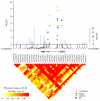Genome-wide association study identifies variants in the ABO locus associated with susceptibility to pancreatic cancer
- PMID: 19648918
- PMCID: PMC2839871
- DOI: 10.1038/ng.429
Genome-wide association study identifies variants in the ABO locus associated with susceptibility to pancreatic cancer
Abstract
We conducted a two-stage genome-wide association study of pancreatic cancer, a cancer with one of the lowest survival rates worldwide. We genotyped 558,542 SNPs in 1,896 individuals with pancreatic cancer and 1,939 controls drawn from 12 prospective cohorts plus one hospital-based case-control study. We conducted a combined analysis of these groups plus an additional 2,457 affected individuals and 2,654 controls from eight case-control studies, adjusting for study, sex, ancestry and five principal components. We identified an association between a locus on 9q34 and pancreatic cancer marked by the SNP rs505922 (combined P = 5.37 x 10(-8); multiplicative per-allele odds ratio 1.20; 95% confidence interval 1.12-1.28). This SNP maps to the first intron of the ABO blood group gene. Our results are consistent with earlier epidemiologic evidence suggesting that people with blood group O may have a lower risk of pancreatic cancer than those with groups A or B.
Figures


References
-
- Jemal A, et al. Cancer statistics, 2008. CA Cancer J Clin. 2008;58:71–96. - PubMed
-
- Ferlay J, Bray F, Pisani P, PArkin DM. IARC CancerBase. No 5. IARCPress; Lyon: 2004. GLOBOCAN 2002: Cancer Incidence, Mortality and Prevalence Worldwide.
-
- Anderson KE,MT, Silverman D. Cancer of the pancreas. In: Schottenfeld D, Fraumeni JF Jr., editors. Cancer Epidemiology and Prevention. Oxford University Press; New York: 2006.
-
- Lowenfels AB, et al. Hereditary pancreatitis and the risk of pancreatic cancer. International Hereditary Pancreatitis Study Group. J Natl Cancer Inst. 1997;89:442–6. - PubMed
-
- Castleman B. Case records of the Massachusetts General Hospital. N Engl J Medicine. 1972;286:1353–1359. - PubMed
Publication types
MeSH terms
Substances
Grants and funding
LinkOut - more resources
Full Text Sources
Other Literature Sources
Medical
Molecular Biology Databases

